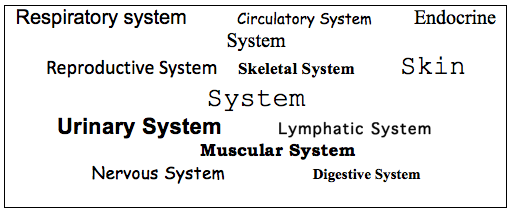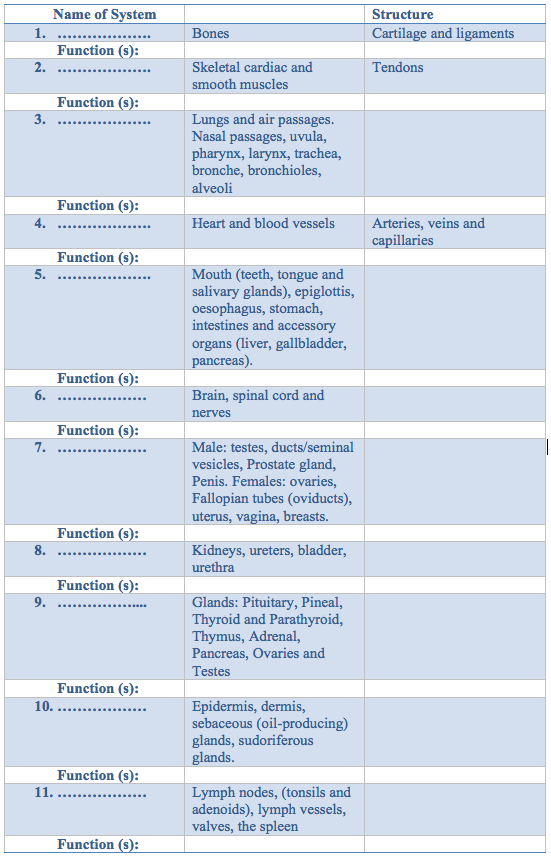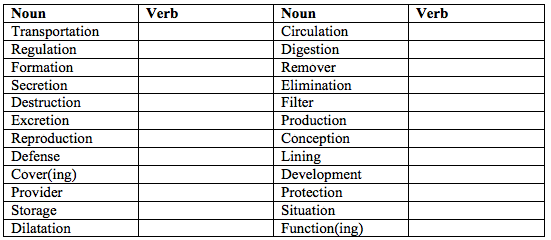Activity 1. Body systems
Here you have the names of different body systems. Examine them and then do the matching exercise below:


VERBS AND NOUNS
In the following exercise, you can see some of the nouns associated with the actions that the body systems perform. The latter are not specified so that you can write the corresponding action for each noun:

THE SKELETAL SYSTEM
Reading.
Choose from the following words to complete the text. Make sure that all verbs agree with the context! (Some of the verbs appear more than once.)
to be, to serve, to produce, to form, to occur, to carry out, to protect, to connect
Functions of the Skeletal System
Its 206 bones _________a rigid framework to which the softer tissues and organs of the body are attached. Vital organs are protected by the skeletal system. The brain is ___________ by the surrounding skull as the heart and lungs are encased by the sternum and rib cage.
Bodily movement is ___________ by the interaction of the muscular and skeletal systems. For this reason, they are often grouped together as the musculo-skeletal system. Muscles are ____________ to bones by tendons. Bones are connected to each other by ligaments. Where bones meet one another is typically called a joint. Muscles which cause movement of a joint are ____________ to two different bones and contract to pull them together. An example would be the contraction of the biceps and a relaxation of the triceps. This produces a bend at the elbow. The contraction of the triceps and relaxation of the biceps ____________ the effect of straightening the arm.
Blood cells are ___________ by the marrow located in some bones. An average of 2.6 million red blood cells are produced each second by the bone marrow to replace those worn out and destroyed by the liver.
Bones ________ as a storage area for minerals such as calcium and phosphorus. When an excess is present in the blood, buildup will ___________ within the bones. When the supply of these minerals within the blood ________ low, it will be withdrawn from the bones to replenish the supply.
THE RESPIRATORY SYSTEM
Basic function of the Respiratory System:
The purpose of the respiratory system is to interchange gases necessary to the function of the body. Each time you inhale, fresh air containing oxygen and other gases enters the body through the nose or mouth. The air is warmed by the body and carried to the lungs through the trachea. Once in the lungs, the air enters the bronchioles, expanding small sacks known as alveoli. A dense capillary network surrounds the alveoli, which is the actual site of gas exchange.
Deoxygenated blood from the pulmonary arteries exchanges carbon dioxide for oxygen at this point, and the oxygenated blood is carried back to the heart via the pulmonary veins. The carbon dioxide then passes through the bronchioles and trachea to exit through the nose or mouth. This process occurs each and every time you breath, providing the body's cells with an effective pathway for gas exchange.
The lungs themselves contain no muscles. The diaphragm, the muscle responsible for respiration, is located underneath the lungs. When you inhale, the diaphragm contracts and moves downward, causing the chest to expand and air to be drawn into the lungs. Upon exhalation, the diaphragm relaxes and rises, forcing air out of the lungs.
Exercise:
Read the following example explaining the relationship between functions in the respiratory system. Notice how the second part of the sentence uses the simple future:
Example: After inhaling, the lungs will fill with air.
In this exercise, complete the first sentence with the appropriate verb forms.
1. After _________ (enter) the nose, the air ________ (pass) through the trachea.
2. Before ________ (fill) the alveoli, the air _________ (move) through the bronchioles.
3. The oxygen ___________ (exchange) places with the carbon dioxide after ___________ (enter) the alveoli.
4. After _________ (exchange) gases, the blood _____________ (return) to the heart via the pulmonary veins.
5. The diaphragm __________ (relax) after __________ (push) out the air.